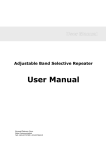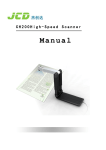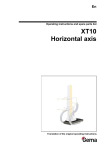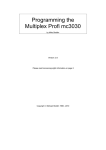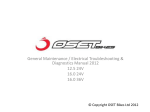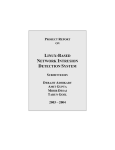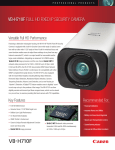Download Dahua Smart IPC User Manual
Transcript
Dahua Smart IPC User Manual INSTALLATION AND CONFIGURATION GUIDE Overseas Sales Department ZHEJIANG DAHUA VISION TECHNOLOGY | 1199 BINAN ROAD, HANGZHOU, CHINA |1 Table of Contents 1 2 3 4 Overview ................................................................................................................ 2 1.1 Summary ................................................................................................................ 2 1.2 Terms ...................................................................................................................... 2 Camera and Deployment Requirement .............................................................. 2 2.1 Summary ................................................................................................................ 2 2.2 Camera Selection and Parameter Setup .................................................................. 3 2.3 Camera Installation Suggestion .............................................................................. 3 2.3.1 Behavioral analysis installation requirement .............................................. 3 2.3.2 Face detection installation requirement ...................................................... 4 2.3.3 People counting angle mount installation requirement ............................... 4 Scene Selection Requirement ............................................................................... 6 3.1 Basic Requirement ................................................................................................. 6 3.2 Example Scenes...................................................................................................... 7 3.2.1 Scenes suitable for intelligent analysis ....................................................... 7 3.2.2 Scenes unsuitable for intelligent analysis ................................................... 8 Intelligent Function Specification ...................................................................... 10 4.1 Defocus Detection ................................................................................................ 10 4.2 Audio Input Abnormity .........................................................................................11 4.3 Intensity Change ................................................................................................... 12 4.4 Tripwire ................................................................................................................ 12 4.5 Intrusion ............................................................................................................... 15 4.6 Object Abandoned / Missing ................................................................................ 17 4.7 Scene Change Detection ....................................................................................... 19 4.8 Face Detection ...................................................................................................... 21 4.9 People Counting ................................................................................................... 22 4.10 Heat Map .............................................................................................................. 25 |2 1 Overview 1.1 Summary This document mainly aims at the requirement description of application environment and onsite installation deployment about some smart devices of Dahua smart IPC and particularly puts forward attentions during application. The document is intended for solution engineer, presale/in-sale/after-sale technical support engineer, project installation personnel, product engineer, test engineer, marketing personnel and company internal personnel (it is not limited to the people mentioned above). 1.2 Terms Field of view: The overall image displayed by the camera. Detection area: The area which is needed to be detected in the image. Blind zone: The area which is not detected in the image. Target: Moving object with some certain type (such as human, vehicle and etc.) which appears in the field. Size filter: Only reserve the target which meets the requirement of size (width height/area) and aspect ratio. DOF calibration: rebuild environment 3-D information. Sensitivity: The difficulty level of target detection and alarm, the higher the sensitivity is, the easier it is to detect, but with more false alarms; the lower the sensitivity is, the less false alarm will be, but with more failed alarms. False alarm: False alarm caused by interference source (light change, leaf waggling, rain & snow, small animals) Failed alarm: it meets the rule condition but fails to trigger alarm. 2 Camera and Deployment Requirement 2.1 Summary It needs to select suitable camera, reasonable installation and setup in order to take effective advantage of algorithm, improve the success rate of detection and reduce failed alarm and false alarm. |3 2.2 Camera Selection and Parameter Setup a) The camera monitoring scene has to be fixed; front-end device can’t be in a state of motion; such as speed dome tour or zoom; b) In the outdoor or indoor backlight environment, select WDR camera if possible in order to avoid part of the image being too dark and bright; c) It is advised to use low illuminance camera in the scene with dark street light; d) It is advised to add light compensation device or use IR camera in the scene without street light and inadequate light; e) It is advised to use wide-angle lens in small and narrow space indoors; f) Please avoid excessive frequency of day/night switch. 2.3 Camera Installation Suggestion 2.3.1 Behavioral analysis installation requirement a) Keep the shoot ground of the camera horizontal, and avoid slope; b) Try to make some certain angle of depression for the angle of view for the camera, generally it is bigger than 20°, it may lead to mutual block and adhesion between targets if shooting horizontally, and cause false alarm and failed alarm; c) If using non-WDR camera, make sure there is no sky arising in the field of view, it may cause part of image being too bright and dark, which is not good for detection; d) Try to make the direction between camera optical axis and target movement as vertical as possible, which is to make the target displacement more obvious and more convenient for detection; such as perimeter protection, the camera should be installed along the perimeter direction; e) The height of camera indoor installation is no lower than 3 meters, and the height of outdoor installation is advised to be 5-10 meters; if it is applied to the fence scene, then the camera installation height has to be higher than the fence; f) The camera should be installed firmly, which is to avoid analysis result due to shaking; g) The camera installation should avoid backlighting, it is advised to use housing during outdoor application; h) When it needs compensation light, make sure the compensation light is uniformly distributed. i) Pay attention to the distance between the compensation light and the camera, it is advised to keep the distance of more than 2 meters; the light is easy to attract mosquitoes; if the |4 distance is too close, it may increase the interference from rain and snow, which may cause false alarm. 2.3.2 Face detection installation requirement There are some factors which influence the performance of face recognition algorithm, such as installation angle, face size and posture, environmental light and etc, the advice of installing camera with face recognition function is as follows: 1) Installation angle requirement The included angle between camera and horizontal line is controlled from 0°to 30°. 2) Face size and posture requirement Left-right rotation [-30°,30°], depression angle and elevation angle [-15°,15°], plane rotation [-15°,15°], without hat, it is not allowed to wear sunglasses, mask, cap and other accessories which block the face, optical frame and hair are not allowed to block the eyes; The width and height of human face should be bigger than 100*100 pixel; 3) Environmental illumination requirement No backlight, no obvious reflected light on the surface, the light is uniform and without shadow. 2.3.3 People counting angle mount installation requirement There are some factors which influence the performance of people counting algorithm, such as camera installation angle, head target size, scene complexity and rule setup. The best installation requirements of the released people counting version are described as follows: 1) Installation angle requirement The included angle between camera and vertical line is from 40°to 60°, see Figure 1 below. Figure 1 Camera Angle Diagram |5 2) Head target requirement The size of human head is more than 100*100 pixels in the 1080P image, which means the head width is between 1/18 and 1/7 of the entire monitoring image width. Figure 2 Head Size Diagram 3) Background requirement Try to select the background with single texture such as ground or wall as the rule area for people counting, see Figure 3. Complex background Complex background Simple background Figure 3 Background Diagram |6 4) Rule requirement The width of the rule area is roughly the width of two or three human heads shown in the figure below, if the counting result is bigger than actual result, it can properly decrease the rule area width; if the counting result is smaller than the actual result, it can properly increase the rule area width. Figure 4 Rule Area Diagram 3 Scene Selection Requirement 3.1 Basic Requirement a) The total proportion of the target should not exceed 10% of the picture; b) The size of the target in the image should not be less than 10*10 pixels, the size of the abandoned object target should not be smaller than 15*15 pixels (CIF image); c) The width and height of the target should not exceed 1/3 of the image height and width; it is advised to make the target height about 10% of the image height; d) The brightness value difference between target and background is no less than 10 gray levels; e) Make sure the target arises at least more than 2 seconds continuously in the field of view, the movement distance exceeds the target’s own width but no less than 15 pixels (CIF image); f) Try to lower the complexity of the monitoring analysis scene if condition is allowed; it is not advised to use IVS functions in the scene where the targets are intensive and the light |7 changes frequently; g) 3.2 Try to avoid glass, ground, water surface and other areas which reflect light; try to keep away from branch, shadow and mosquito interference area; try to keep away from backlight scene, and avoid direct light. Example Scenes 3.2.1 Scenes suitable for intelligent analysis Indoors Outdoors Wall |8 3.2.2 Scenes unsuitable for intelligent analysis SN Problem description 1 Vehicle light shoots directly, serious glare, contrast ratio appears low. 2 The camera installation height is too low; the angle of view is too horizontal, which causes the target to be seriously blocked. 3 The camera installation height is too low, angle of view is horizontal, which causes the size of monitoring target to become smaller rapidly, and influences the effective monitoring distance of intelligent analysis, resulting in missing detection of distant targets. Example pictures |9 4 Entrance and exit position, the door itself and opening or closing the door may cause light change and serious interference to the detection. 5 The warning line is set in the interference area, which may cause false detection when opening or closing the door. 6 The detection area is blocked; the buffering area of both sides of the warning line is too small. 7 Too much interference from trees to the top of wall, which makes it easy to cause false alarm. | 10 8 Scene with too many targets, seriously crowded. 4 Intelligent Function Specification Note: The interface shown in the following article belongs to the current version, please be noted that there may be minor modification later. 4.1 Defocus Detection Function Description: Defocus detection is to detect if there is any image out of focus in the video and causes the image to become blurry. It can activate record, snapshot and alarm according to the judgment result. Figure 5 Defocus Detection Setup | 11 Operation Steps: 1. Click “Enable Defocus Detect” 2. Working period setup, default is all day. 3. Support alarm activation setup: record, relay-out, send email and snapshot. 4. Click “Save” to complete settings. 4.2 Audio Input Abnormity Function Description: It is to judge if audio input is abnormal, such as clipping audio cable by people. It can activate record, snapshot and alarm according to the results. Figure 6 Input Abnormal Setup Operation Steps: 1. Click “Enable Input Abnormal” 2. Working period setup, default is all day. 3. Support alarm activation setup: record, relay-out, send email and snapshot. 4. Click “Save” to complete settings. | 12 4.3 Intensity Change Function Description: It is to judge if the intensity value surpasses the set threshold; it can activate record, snapshot and alarm according to the result. Figure 7 Intensity Change Setup Operation Steps: 1. Click “Enable Intensity Change” 2. Set sensitivity and threshold. 3. Working period setup, default is all day. 4. Set Anti-Dither time. 5. Support alarm activation setup: record, relay-out, send email and snapshot. 6. Click “Save” to complete settings. 4.4 Tripwire Application Scene: It can only be applied to the scene where the targets are sparse and there is rarely any covering between targets, such as the perimeter without any guard. It will trigger alarm when the target passes through the warning line according to the set movement direction. It takes some time from the target appears to the target is confirmed, so it needs to leave some space when setting warning line, do not set it near the covering. | 13 Function Description: It is to detect if there is any object crossing the warning line, it can support different direction selection, such as A->B, B->A and bidirectional, and it can activate record , snapshot and alarm according to the judgment result. A->B Figure 8 Tripwire Setup 1 B->A Figure 9 Tripwire Setup 2 | 14 Bidirectional Figure 10 Tripwire Setup 3 Operation Steps: 1. Click “Enable” button, the default rule name is line 1, line 2, line 3, and line 4 when adding rules, users can modify the rule name. 2. Click “Draw Rule” and draw a warning line in the image according to the actual needs, it will trigger alarm when the target is crossing the warning line according to the set movement direction. 3. Select one of the following directions: A->B, A<-B, A<->B and it is to judge if it will trigger intelligent alarm when tripwire happens according to the selected direction. 4. Working period setting, default it all day. 5. Support alarm activation setup: record, relay-out, send email and snapshot. 6. Target filter can set max size and min size; which means the max and min target it can detect. 7. Click “Save” to complete settings. | 15 4.5 Intrusion Application Scene: It is similar to warning line. It needs to leave some space for target movement outside the perimeter if it is to detect enter and leave event; It can only be applied to the scene where the target is sparse and there is rarely any covering between the targets, such as the perimeter without any guard. It will trigger alarm when the target is entering or leaving the area. Function Description: It is to detect if there is any object entering or leaving the area, it will trigger rule when crossing the area perimeter, support enter, leave and enter&leave three direction selection, it can activate record, snapshot and alarm according to the judgment result. Enter Figure 11 Intrusion Setup 1 | 16 Leave Figure 12 Intrusion Setup 2 Enter & Leave Figure 13 Intrusion Setup 3 | 17 Operation Steps: 1. Click “Enable” button, the default rule name is area 1, area 2, area 3 and area 4 when adding rules, users can modify the rule name. 2. Select detection action list: when selecting “Cross” in the detection action list, the direction can be set as: enter, leave and bidirectional. 3. Click “Draw Rule” and draw a warning area in the image according to the actual needs, it will trigger alarm when the target is crossing the warning area perimeter according to the set movement direction. 4. Working period setting, default is all day. 5. Support alarm activation setup: record, relay-out, send email and snapshot. 6. Target filter can set max size and min size; which means the max and min target it can detect. 7. Click “Save” to complete settings. 4.6 Object Abandoned / Missing Application Scene: It can be applied to the scene where the target is sparse and there is no obvious or frequent light change. Missing alarm will increase in the scene where target density is high and there is frequent covering; false alarm will increase in the scene where there are too many people. As for the detection area, it needs to be simple; it is not suitable for the too complicated area. Function Description: Object abandoned means that it is to detect if there is any object abandoned in the designated detection area and surpass the set time. It will activate record, snapshot and alarm according to the judgment result. Object missing means that it is to detect if there is any object moved in the designated area and surpass the set time. It will activate record, snapshot and alarm according to the judgment result. Note: The system makes statistics of the still areas in the foreground area and distinguishes if it is abandoned or missing according to the similarity of foreground and background, it will trigger alarm when surpassing the set time; Due to the fact that the system distinguishes object abandoned or missing according to the similarity of foreground and background, it may cause mistake of distinguishing classification in a situation where foreground and background are both very complicated. It also triggers abandoned alarm if passengers and vehicles stay for a long time. In order to filter such alarms, generally the abandoned object is smaller than people and vehicle, and then users can filter people and vehicle via setting min and max filter. Besides, users can avoid false abandoned alarm caused by people short stay via properly extending alarm time. | 18 Object Abandoned Figure 14 Objected Abandoned Setup Object Missing Figure 15 Object Missing Setup | 19 Operation Steps: 1. Click “Enable”, the default rule name is object1, objet 2, object 3 and object 4 when adding rules, users can modify the rule name. 2. Rule type select “Object Abandoned” or “Object Missing”. 3. Set minimum keep time, which means the stay time or disappear time of target when triggering alarm. 4. Draw a detection area. As for object abandoned, it will trigger alarm when the abandoned object surpasses the time set by users in the monitoring scene; as for object missing, it will trigger alarm when the moved object surpasses the time set by users in the monitoring scene. 5. Working period setup, default is all day. 6. Support alarm activation setup: record, relay-out, send email and snapshot. 7. Target filter can set max size and min size, which means the max and min target it can detect. 8. Click “Save” to complete settings. 4.7 Scene Change Detection Video scene change function is used to detect if the camera is covered or moved and other abnormities of monitoring scene change. The intelligence base will compare the images before and after being covered or turned to judge if there is any similarity; if not it will generate alarm; pay attention to the following points about video scene change function: A. Avoid the scene with big difference of image brightness when turning on and off the light. Image with light on Acceptable effect after light off Unacceptable effect after light off | 20 B. The scene needs to include some reference area which is not blocked by moving object and is changeless with some clear details; See the scene in the left figure below, it is not suitable for scene change detection because the moving crowd occupies most part of the image and there is no fixed area for reference, which is easy to generate false alarm; See the scene in the right figure below, there is fixed area such as ceiling and wall for reference besides moving crowd, which is suitable for detection analysis. Unreasonable Reasonable C. Avoid application in the tunnel and places with severe disturbance of vehicle lights. Function Description: Scene change is to detect if the video scene is changed due to external factors, such as turning camera angle by people to change camera scene, and it can activate record, snapshot and alarm according to the judgment results. It will generate alarm when the whole monitoring image changes due to the situations that the camera is blocked, moved or strong light change. | 21 Figure 16 Scene Change Setup Operation Steps: 1. Click “Enable”. 2. Working period setup, default is all day. 3. Support alarm activation setup: record, relay-out, send email and snapshot. 4. Click “Save” to complete settings. 4.8 Face Detection Function Description: Face detection is to detect if there is any human face appearing in the video, and capture the face then send it to the rear-end for analysis and processing, it can activate snapshot, record and alarm. | 22 Figure 17 Face Detection Setup Operation Steps: 1. Click “Enable”. 2. Click “Enable Face Enhancement” to enhance the face image display. 3. Select max and min size, draw max and min target for target filtering. This step is to filter target, which can’t be operated under default status. 4. Activate record, alarm, email and snapshot according to the requirements. 5. Target filter can set max target and min target, which means the max and min target it can detect. 6. Click “Save” to complete settings. 4.9 People Counting Function Description: It is to make statistics of enter and leave people in the specific area of the image, and finally it comes out the statistics data, providing kinds of data reports such as day report, month report and year report. There are two ways to present: line chart and bar chart, providing data exporting function. Note: People counting supports max half year data, it will operate auto overwrite according to hour when surpassing one year. | 23 Figure 18 People Counting Preview Figure 19 People Counting Setup | 24 Operation Steps: 1. Click “Enable”. 2. Enable flow statistics overlay. The step is to overlay enter and leave number of people in the video. 3. Working period setup, default is all day. 4. Click “Draw” button, draw a rectangle in the entrance and exit where it needs to count people, select enter and leave direction. 5. Set the alarm threshold of enter number, leave number and stay number. 6. Set activated record, alarm, email and snapshot according to the requirements. 7. Click “Save” to complete settings. Data Representation: The statistics can be exported as line chart, bar chart or excel files. Line Chart Figure 20 Line Chart Diagram | 25 Bar Chart Figure 21 Bar Chart Diagram Operation Steps: 1. Enter report interface, select report type, such as day report, month report and year report. 2. Select the time of statistics report. 3. Select flow direction of statistics and ways to present of the report including bar chart or line chart. 4. Click Search button to view the report presentation. 5. Click export to save report as CSV format or picture format. 4.10 Heat Map Function Description: It supports people crowd density statistics within the set time range, and presents in the space with different colors. Color level is divided into red, orange, yellow, green and blue, which means the crowd density ranges from high to low, red means high density, blue means low density. Note: Currently heat map function only supports 7-day heat map data, it will auto overwrite according to hour when surpassing 7 days. If users set flip mode, the previous heat map data will be cleared. | 26 Figure 22 Heat Map Setup Figure 23 Heat Map Diagram | 27 Operation Steps: 1. Click “Enable” button. 2. Set working period. 3. Click “OK” button to complete heat map setting. 4. Enter report interface, select the period you need to check, click “search”. 5. Click “Export” to export pictures.




























